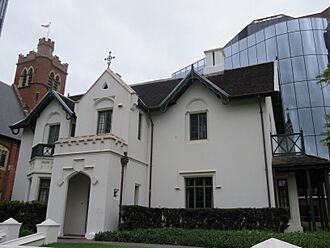The Deanery, Perth facts for kids
Quick facts for kids The Deanery |
|
|---|---|

The Deanery in March 2022
|
|
| General information | |
| Type | Office |
| Location | Perth, Western Australia |
| Coordinates | 31°57′22″S 115°51′41″E / 31.9561°S 115.8615°E |
| Type | State Registered Place |
| Designated | 1 December 1995 |
| Reference no. | 2100 |
The Deanery is a historic building in Perth, Western Australia. You can find it on St Georges Terrace, right where it meets Pier Street.
This special building was constructed in the late 1850s. It was first used as a home and office for Reverend George Pownall, who was the very first Dean of Perth. Today, The Deanery is still important. It's one of the few old houses from that time left in Western Australia, and it now serves as offices for the Anglican Church.
Contents
The Deanery's Early Days
Who was Reverend George Pownall?
In 1855, George Pownall became the Colonial Chaplain. Two years later, in 1857, he became the first Dean of the new Saint George's Cathedral in Perth. He needed a place to live and work.
Where was The Deanery built?
The land where The Deanery stands today used to be the site of the old Perth Gaol (a jail). In July 1858, this land was swapped with the government. This allowed The Deanery to be built close to the Cathedral.
How was The Deanery designed?
Reverend Pownall was very interested in architecture. He was part of groups that liked the Gothic style of building. This interest greatly influenced how The Deanery looked. The main architect for the building was Richard Roach Jewell.
Pownall wrote that the building would cost about £900. The government, public donations, and the Anglican Church each paid £300. This amount is like A$Error when using : |start_year=1,859 (parameter 3) is lower than the earliest available year (1,901) in index "AU". today. The building was constructed by former convicts who had earned their freedom.
When did Pownall move in?
Reverend Pownall moved into The Deanery in November 1859. For over 90 years, it was continuously used as a home. The building was updated in 1918, 1932, and 1936 to keep up with modern living standards.
Saving The Deanery
Why was The Deanery almost demolished?
In 1953, the church leaders wanted to knock down The Deanery. They planned to build a tall office building there instead. Many people protested this idea, and The Deanery was saved!
The new Dean, John Bell, asked for financial help to preserve the building. People donated money, and The Deanery was modernized. After that, it was used as both an office and a home for church staff.
When was The Deanery restored?
By 1979, The Deanery needed a lot of repairs. An appeal was started to raise $90,000 for its restoration. They raised even more, $95,736, with a large part coming from the National Trust.
The building and its garden were carefully restored. The Deanery reopened to the public on May 8, 1982. Since then, it has been used as the Cathedral offices.
Recognizing its Importance
The Deanery is a very important historical building. It was added to the Register of the National Estate in March 1978. It was also recognized by the National Trust of Australia (WA) in October 1980. On December 1, 1995, it was officially placed on the permanent state heritage register. This means it is protected for future generations to enjoy.


